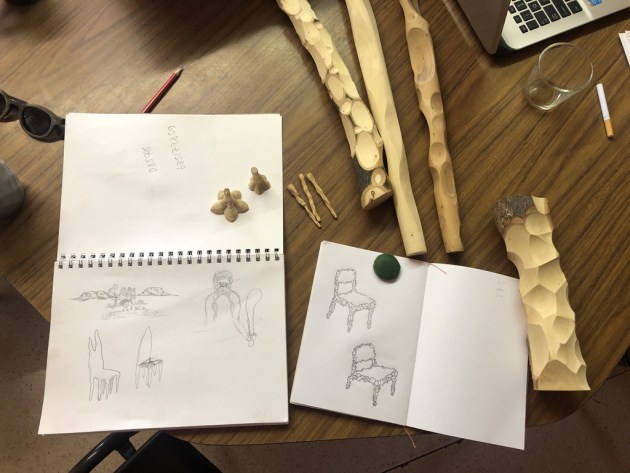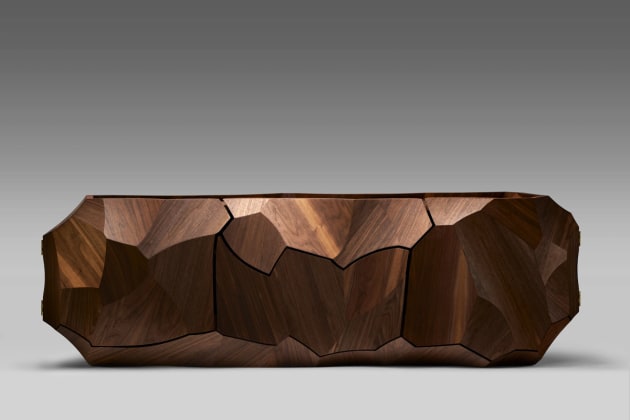Telling stories: Kurunpa kunpu
Words: Linda Nathan
Three years ago, three people with very different backgrounds got together and made the collection of work now known as Kurunpa Kunpu: Strong Spirit.
The people
Tanya Singer, a Minyma Anangu woman and Errol Evans, a Djabugay and Western Yalanji man, live in Railway Bore, South Australia around 700k north of Adelaide. Out on Country ‘there’s just wide open spaces, no traffic and it’s nice and quiet – we can do whatever we want out here’, said Errol.
Errol makes a range of artefacts which Tanya burns and paints, in addition to creating her own punu (woodcarvings). Both sell their work through Maruku Arts Gallery in Uluru. ‘I normally use mulga and iron woods, and a bit of dead finish, which is another shrub that grows around here,’ said Errol. Collecting and working wood is a lifestyle he enjoys: ‘When I’m out looking for a certain type of tree or branch, I feel at peace with myself because there’s no noise around me, no hassle, no bustle...it’s peaceful.’

Tanya Singer and Trent Jansen on Country. Photo: Liane Wendt
The suggestion to collaborate with another artist came from Maruku Arts and led to the invitation extended to Trent Jansen. Trent is a furniture and object designer from Thirroul (Dharawal Country) on the NSW south coast who works with a process called design anthropology.
Asked to explain the latter, Trent said: ‘Design anthropology comes from Jules Prown’s material culture theory that says the things we make are the physical embodiment of our values, ideas, attitudes and assumptions. My idea is that if we can automatically design something and have it embody our culture, then surely we can do this in a purposeful way by identifying the cultural values that we want to embody and then set about trying to incorporate them.’

Trent Jansen (left), Tanya Singer and Errol Evans on the way out to Railway Bore, SA.
The design process
The long timeframe of the project was due in part to Covid travel restrictions, but eventually the three were able to spend time together. ‘Tanya and Errol invited me out to their homelands’, said Trent. ‘On our first trip, I went to Railway Bore and spent two weeks with Tanya and Errol getting to know each other, understanding the way we usually practice and the influences that shape our work. Tanya and Errol took me out on Country; we felled wood and Tanya taught me about this remote region of South Australia, where she has lived most of her life.’ With that knowledge, the research and design process could develop.
Early design workings and samples. Photo: Trent Jansen
‘We couldn’t really travel freely at that time, that’s why we ended up doing a sketch exchange and catching up over the phone and emails – at least we had the technology to communicate’, said Tanya.
‘There were long periods spent apart, communicating regularly via email, text and phone to send ideas back and forth in the form of sketches, 3D models and material samples’, said Trent. ‘Eventually, when we did spend time in Sydney with Trent, that made it easier and enabled us to complete sketches and get things done face-to-face,’ said Tanya.

Cracked earth... Photo: Tanya Singer
Inspiration for the designs came literally from the ground up as samples of wood were carved with the cracked earth motif they witnessed – this was then translated into the textured and faceted surfaces of the chairs and cabinets that eventuated. The designs were a joint effort; first the chair, and then came the idea for a cabinet with a ‘kind of monolith look’ that opens to reveal a surprise, explained Tanya.
The wood
While Errol and Tanya normally use local woods, the species used for the Kurunpa Kunpu collection were American hardwoods, the supply of which was readily available in the sizes and sections required for the chairs and cabinets produced. ‘The fact that it was carbon negative was even more of a plus – and every tree tells a story’, said Errol.

Kutitji chair designed by Errol Evans with Trent Jansen. Photo: Fiona Susanto
The Kutitji chair design is based on the kutitji or shield artefacts that Errol carves, and was developed together with Trent into a coopered lounge chair form. The backrest is supported by a ‘shield handle’ that serves to strengthen the construction. The design also carries an environmental message, explained Errol: ‘The shield represents the earth’s ozone layer – without that we’re all vulnerable – it’s our defence.’

Errol Evans at Melbourne Design Fair, May 2023 seated on the American cherry Kutitji chair he designed with Trent Jansen. Photo: Raf Nathan
Making the work
The fourth and indispensable partner to the project was Chris Nicholson at Mast Furniture in Brisbane. ‘Chris was heavily involved in the design development of the work, establishing new methods of production in order to realise these complex pieces’, said Trent.
‘When I first saw the pencil sketch of that (Manta Pilti) cabinet, I thought, “oh god, what have I got myself into!”’, said Chris. ‘The good thing was that we had time. They already had a clear idea for what they wanted to achieve, so we were just back and forth about the finer details until we were happy and the making could start, but it was still very challenging.’

Manta Pilti (Dry Sand) cabinet, American hard maple, designers Tanya Singer and Trent Jansen, maker Chris Nicholson. Photo: Fiona Susanto
The Manta Pilti (Dry Sand) cabinet carcase is made of around 50 facets, individually cut and joined. ‘The facets are in essence sections of a cylindrical form and no two facets are the same. The facets are curved laminations because with all the alternating grain directions, it just wouldn’t have worked in solid timber – it wouldn’t have been stable enough,’ explained Chris.

The cabinet was made over a three-month period, and according to Chris it took weeks of CNC programming just to produce the components. ‘There are hundreds of individual joins and if you think about it, even a 0.1mm inaccuracy in each of these joints would have compounded to a huge gap.’
Once all the facets for the carcase had been cut, it was also time-consuming gluing them together. ‘For the carcase we started at the bottom, working up and adding one facet at a time. It took a few days to glue the whole carcase.’

Project take-aways
What can we learn through cultural exchange and collaboration? ‘It’s broadened my mind’, said Tanya. ‘This has made me realise I’m capable of coming up with ideas and telling stories through other mediums.’
‘I’ve really enjoyed this whole project’, said Errol. ‘I make artefacts all the time and sometimes get sick of making the same thing over and over – it’s been good doing something different and new. I’ve gotten heaps out of this project. It’s given a new perspective on what’s going on in the world, and it’s given me a way of showing what’s going here in Country, right in my own backyard. It’s been a good challenge and I’ve enjoyed every moment.’
‘It’s been a way of coming together...,’ said Tanya, ‘...and building new friendships and collaborating with other designers’, continued Errol. ‘It’s been telling our story, about what’s going on here in Country, right here and now.’
‘I have learned so much from the cross and inter-cultural collaborations I have worked on over the years’, said Trent. ‘They have fundamentally changed me as a person. With the influence of my collaborators, I am beginning to see the world differently, understanding the relational links between all aspects of ecosystem and my place within these ecologies, not hierarchically above them.
‘I have learned new methods of creativity, new ways of seeing creative influence and new approaches to embodying these influences. I have learned new methods for shaping material, producing texture, and making artefacts. I have learned to shut up and listen. Most importantly, we have used design and the making of things as practical acts of reconciliation, to begin to break down our differences and painful histories and meet as friends and allies with a shared purpose.’
Manta Pilti (Dry Sand) credenza, American walnut, designers Tanya Singer and Trent Jansen, maker Chris Nicholson. Photo: Fiona Susanto
‘In the end I just saw (the project) as a group of friends making something beautiful’, said Chris. ‘It was a very rewarding process to work alongside Tanya, Errol and Trent to help them realise their designs. Together we produced a collection we are all immensely proud of.’
Cross-cultural exchange can be a way for people to tell stories through the objects they design and make, but for that to work we need to let others speak, and then listen to them.
Kurunpa Kunpu was exhibited at Melbourne Design Fair, Artbank Melbourne and Fremantle Arts Centre from May – July 2023. The project was funded by American Hardwood Export Council and supported by the Australian Government through the Australia Council, its arts funding and advisory body, Arts South Australia, the Department of the Premier and Cabinet, the University of New South Wales Art & Design, Maruku Arts, The National Gallery of Victoria’s Melbourne Design Week and Fremantle Arts Centre.
Tanya Singer and Errol Evans’s work is represented by Maruku Arts, see maruku.com.au
Learn more about Trent Jansen at trentjansen.com
Chris Nicholson is a partner at Mast Furniture, see mastfurniture.com.au
First published in Australian Wood Review, issue 120, September 2023




